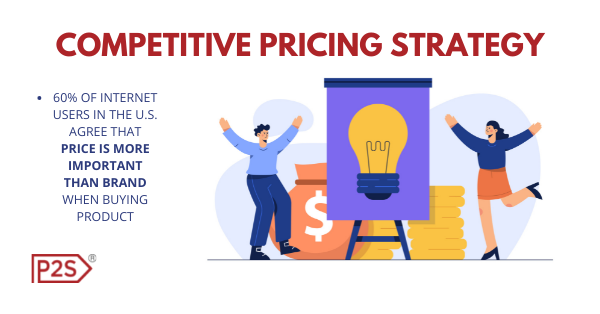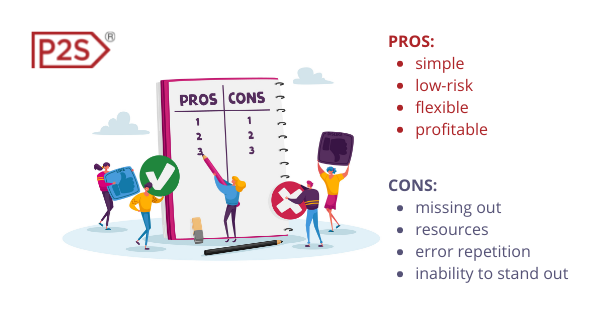
Competitive Pricing Is One Of The Best Yet Simplest Pricing Strategies
There is no doubt that price is the most important factor for consumers when paying for a product or service. It’s no surprise that 60% of internet users in the U.S. agree that price is more important than brand when buying a product. So, the right pricing strategy is an essential part of a good business, but with so many pricing models out there – it’s not easy to make the right choice. The other thing is, you should be aware that you are not working in a vacuum, so, not considering your competitors’ prices when making a pricing decision can be a fatal mistake. This is why we believe that competitive pricing is one of the best yet simplest pricing strategies in a long term.
In the following paragraphs, we will try to explain what is competitive pricing and provide some real-life examples of it. We will then consider the advantages and disadvantages of competition-based pricing and give a small guide on how to perform competitive pricing right.

What is Competitive Pricing?
Definition
Competitive pricing or competition-based pricing is a pricing strategy where you take into account the prices of your competitors when setting your products’ prices.
This pricing method is usually used for homogenous products in highly competitive markets and can be also referred to as market-oriented pricing.
Strategies
When it comes to competitor-based pricing, you have three options:
- Go above the price of your competitors – this strategy can be used when you decide to increase your revenue and even try to increase sales by setting a higher price compared to your competitors. Even though it might not sound like an intuitive move at the first glance, setting a higher price can help you with your brand’s image. But you need to be careful – if you want to charge more, you need to offer more, so think about extra features and premium options your service or product can offer.
- Following competitors’ prices – you can set your prices to be equivalent to the prices of your competitors. When you do this, the price as a factor is eliminated, so the focus is moved to the brand itself and on features, the product can offer. So, if you can offer more than your competitors, this might be a good strategy for you.
- Go below the price of your competitors – here you need to be careful. If you are new and trying to get your part of the market share or just trying to survive in a competitive market environment, this pricing method might help you. However, it is a risky move, since you have to consider your profit margin, and you don’t want the lower price to negatively affect your brand’s image.
Free 14-day trial!
Start your Price2Spy trial now, and see how it can ease the process of implementing your pricing strategy.
Try for freeWhat are Competitive Pricing Examples?
Let’s take two of the most successful smartphone brands at the moment. Apple and Samsung are competing for the customer’s attention and their marketing and pricing strategies are worth very serious studying. We will just take a quick look and see what they do with their prices. Since the prices in this industry are very dynamic and change over time, we will take the prices on the release dates, to avoid any inconvenience. Also, we need to have in mind that Apple and Samsung don’t release their phone at the same time. Apple usually releases its most popular phones in October, while Samsung does this in January. Disregarding the fact that it’s not the same year, we will take the shortest period between the two releases and compare the phones Apple released in October 2020. (iPhone 12, iPhone 12 Pro, and iPhone 12 Max – released in November) and phones Samsung released in January 2021 (Galaxy S21, S21+, and S21 Ultra). Since Samsung was the one who released its products later, they had the chance to look at Apple’s prices.
With the S21 and S21+, Samsung decided to go a bit below the price of iPhones 12 and 12 Pro. On the other hand, Samsung felt more comfortable with S21 Ultra and decided to go with the price of £1,329 which is considerably more expensive than Apple’s most premium phone in this series – the iPhone 12 Pro Max cost £1,099 at launch. This can be seen as Samsungs message that they are offering a phone with better features than Apple offered a few months before. Conversely, FitSW which provides software for personal trainers utilizes competitive pricing to offer more features at a slightly lower price point than its competitors.
Another great example of competitive pricing that is not coming from two brands competing is Amazon. The key to its success is very carefully done competitive pricing intelligence. This allows them to always offer the cheapest price for a product and in this way beat their competition.
Pros and Cons of Competitive Pricing
In the world of business, nothing is black and white. There is no pricing strategy perfectly tailored for everyone and in every situation. It is more likely that a pricing strategy one brand use with success can be a total mistake for a brand in a different industry or market. We are going to explain the advantages and disadvantages of competitor-based pricing, with the idea to allow you to decide for yourself if this is going to work for you.

Advantages of competition-based pricing
- Lower Risk – the possibility of making mistakes with pricing when you are new on the market is big. However, if you rely on the prices of your already established competitors, you are lowering the risks, since they spent some time deciding their prices and testing them on the market.
- It’s simple – this is a relatively simple strategy since it requires you to decide who are your main competitors and collect their prices, then make a decision based on the data. Of course, in some industries, this can be a very demanding task, because of the huge number of products and frequent price changes.
- Flexibility – you can always combine competition-based pricing with other pricing models to come up with a perfect price.
- Earn more – by using reliable price tracking software, you will be able to lower the prices where you have space, and take over some customers from your competitors, but on the other hand, you will be informed about opportunities to set the higher price and remain competitive, leaving you with a win-win situation.
Disadvantages of competition-based pricing
- Missing out – there is a potential risk of missing some important details your competitors’ products might have. This could lead to mistakenly set prices.
- You won’t stand out – if you decide to follow the prices of your competitors, you will be one of many, so you won’t be able to stand out, and it will get harder for you to build something recognizable.
- Making the same mistake – you can do your competitive pricing analysis right, but what if your competitors made some mistakes while setting their prices? You will make the same mistakes, and miss an opportunity to beat them by setting the right prices.
- Resources – for smaller companies, the task of collecting and comparing prices can be hard to manage and would require more people and resources. This can be overcome by using price monitoring software since some of those come with relatively affordable monthly prices.
How to Perform Competitive Pricing?
Although we stated that competitive pricing is one of the easiest pricing methods to perform, in some cases this could be a time-consuming task whit a few potential points where you can make a mistake. Furthermore, if you don’t do the competitive pricing analysis right, the whole pricing process will be endangered.
The process of competitive pricing can be separated into two big steps:
- Competitive pricing intelligence
- Setting the right price
Competitive pricing intelligence is a process of gathering and analyzing information about your competitors’ prices. This is an essential part of the competitive pricing strategy since the later decision will be made based on the data you have collected and their analysis.
The easiest and most reliable way to conduct competitive pricing intelligence is by using price monitoring software specialized for those tasks. Good software will not only save you time and resources for gathering pricing information, but it will also open a door to dynamic pricing, allowing you to update your prices depending on the pricing rules you set based on competitor pricing information.
Potential Challenges and Mitigation
Let’s also cover what could be the potential challenges when implementing this pricing strategy:
Price wars and margin erosion
Price wars and margin erosion are common challenges businesses face when engaging in competitive pricing strategies. Price wars occur when competitors continually lower their prices to gain a larger market share, resulting in a race to the bottom. While this may benefit consumers in the short term, it can lead to significant financial losses for businesses.
Margin erosion refers to the gradual reduction in profit margins as prices are lowered to remain competitive. The key to mitigating these risks lies in finding a balance between offering competitive prices and maintaining profitability through other means, such as cost optimization, product differentiation, or value-added services.
Maintaining profitability while remaining competitive
Maintaining profitability while remaining competitive is a crucial objective for businesses. It requires a delicate balance between offering competitive prices and ensuring that the company’s financial health is sustained. To achieve this, businesses can focus on several key strategies.
Firstly, optimizing operational efficiencies and reducing costs can help preserve profit margins. Secondly, businesses can explore ways to differentiate their products or services, allowing them to command higher prices based on unique value propositions.
Additionally, enhancing customer loyalty and repeat business through exceptional customer service and personalized experiences can help maintain profitability.
Strategies to address challenges, such as value-added services or product differentiation
Strategies such as value-added services and product differentiation can be effective in addressing challenges faced by businesses. Value-added services involve providing additional benefits or features that go beyond the core product or service, enhancing its perceived value to customers. This can include offering extended warranties, free installation, or personalized customer support. By incorporating value-added services, businesses can justify higher prices and differentiate themselves from competitors.
Product differentiation, on the other hand, involves creating unique features or characteristics that set a product apart from others in the market. This can be achieved through innovative design, superior quality, or exclusive functionality. By differentiating their offerings, businesses can attract customers who are willing to pay a premium for the distinctive features.
By implementing these strategies, businesses can address challenges such as price competition and stand out in a crowded market, ultimately increasing their profitability and market share.
Conclusion
In a world where the price is almost everything, you need to always keep an eye on your competitors. Having the right price at the right moment can benefit your business a lot. This is why a good pricing strategy is key to success. Competitive pricing is, with no doubt, one of the most reliable strategies that can help you out., and it is used by everyone, from small businesses to giants like Samsung or Amazon. Performing competitive pricing right can sometimes be demanding, and this is why we recommend using software to help you out. Price2Spy is one of the best price monitoring tools available. Try it for free and see which benefits you can get from it.



